This easy homemade New York-Style Bagel recipe is simply the best! Basic pantry ingredients transform into deliciously chewy freshly made New York bagels.
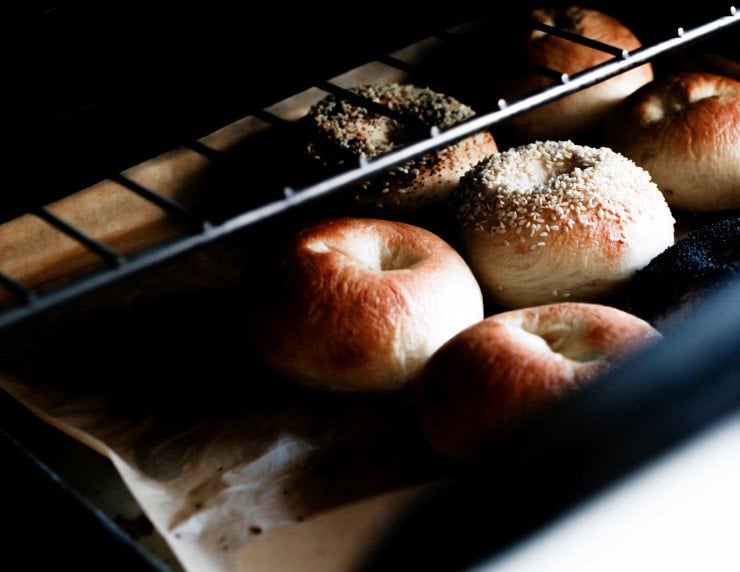
This is simply the best homemade New York-Style Bagel Recipe. After so much love (this recipe has received over 11 years worth on here!), I had to share the recipe in Hand Made Baking, and I updated this page with various photos, tons of tips, tricks, and information you’ll need to achieve the most perfect chewy homemade bagels.
This easy bagel recipe is delicious and results in perfection. It does not need as much dedication as other bagel recipes you will find on the web– you do not need to dedicate 2 days to this. It’s a same-day homemade bagel recipe that comes together in 2 hours.
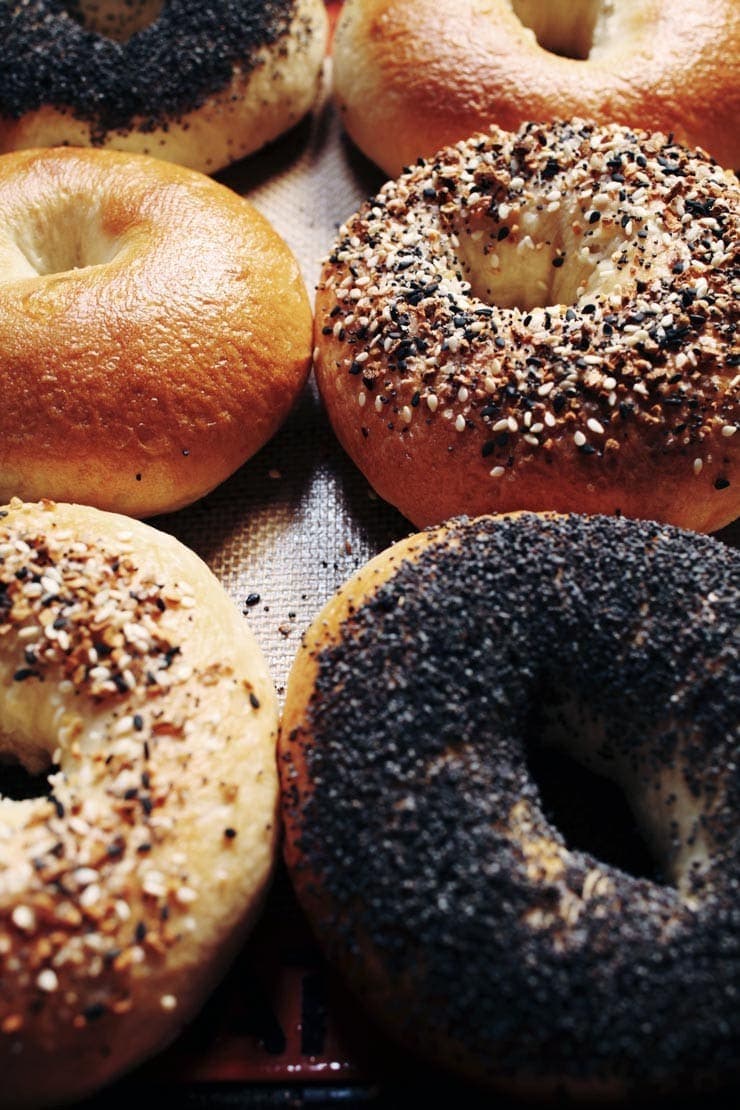
As a native New Yorker, I know there’s nothing better than a fresh bagel schmeared with cream cheese. I have a high standard when it comes to bagels and I don’t put unusual ingredients in mine.
In these bagels, you will not find any yogurt, maple-syrup, or ingredients you might not have in your pantry.
I no longer live in New York City, and I constantly crave the good old-fashioned bagels I grew up on– flavorful, modestly sweet, and chewy with soft, shiny crusts. These bagels are made the classic way: you boil them in water for a couple of minutes before you bake them. This is probably one of the most bizarre things a person can do to dough, but it just works.
This bagel recipe is a very altered adaptation of one from a cookbook, Ultimate Bread, that I borrowed over a decade ago from my aunt. It was my first introduction to homemade bagels. Over the years, this has become the best bagel recipe that I’ve ever made.
It doesn’t require unusual ingredients or require special equipment to make the recipe. These homemade chewy bagels are a treat fresh out of the oven, but when they’re toasted– oh, my! Can we just say that you’ll be making this bagel recipe time and time again?
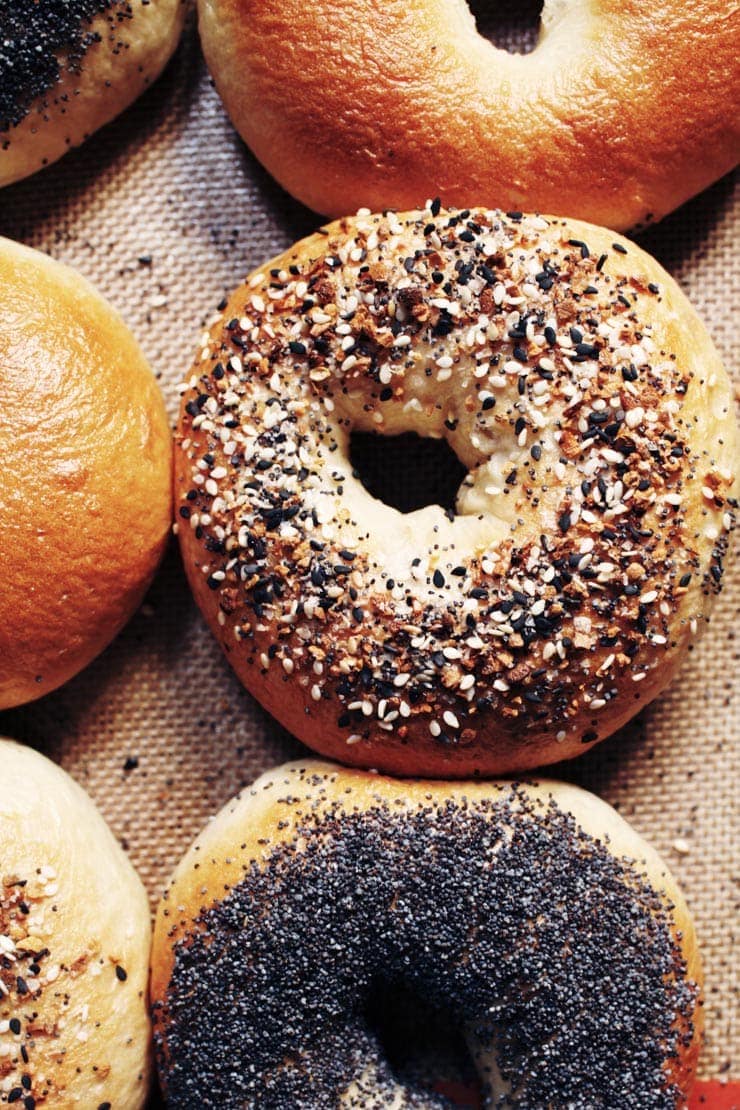
After making this New York-Style bagel recipe on your own, you will feel a sense of accomplishment and satisfaction. I know I always do! This will definitely give some competition to your local bagel shop- the recipe is that good (I mean, look at the comments!).
This homemade bagel recipe is so good that you’ll be impressed with yourself and totally satisfied after you take a nice bite out of one of these freshly made chewy bagels. So, if you mail order bagels from your favorite spot in New York City and pay $7.50 a bagel, save your money!
And if good bagels cannot be found where you live, worry no more; this recipe is infinitely adaptable, and the little bit of effort you put into making these bagels is well worth it. It’s time to get baking!
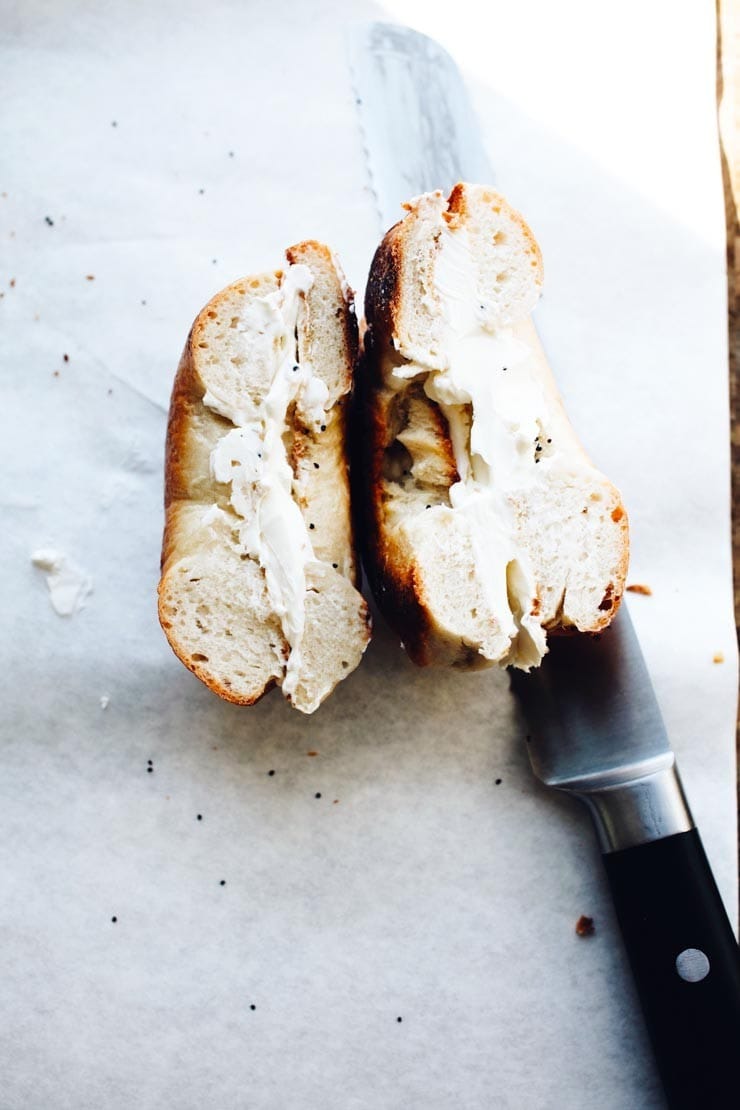
Homemade Bagel Recipe Ingredients
This homemade bagel recipe consists of four major parts– making and preparing the bagel dough, shaping and boiling the bagels, the bagel topping, and the things you’ll need to serve them with. Here’s what you’ll need:
The Bagel Dough: The Bagel Recipe Ingredients
- Granulated Sugar: This is used to slightly sweeten the bagel dough and to activate the yeast.
Feel free to use natural cane sugar here if you have it. - Active dry yeast: Yeast is used to help the bagel dough form and rise.
- Luke warm water: This needs to be between around 105ºF/ 40.5ºC and 115ºF / 46ºC; this will also help the yeast activate and bind the flour and other ingredients into a smooth, elastic bagel dough. On the rare occasion, you may need more water than listed in the recipe. The water called for in the recipe is a guide– your ultimate goal is to form a smooth bagel dough that is moist and firm.
- Bread flour: Bread flour contains a high protein content, perfect for making homemade bagels that are chewy. All-purpose flour works here too, they will be just as delicious– just not as chewy as ones made with bread flour (Read: New York-Style Bagel Recipe FAQ located below the recipe in this post for more information about flour alternatives for these homemade bagels).
- Fine-Grain Sea Salt: Salt adds the right amount of flavor to the bagels.
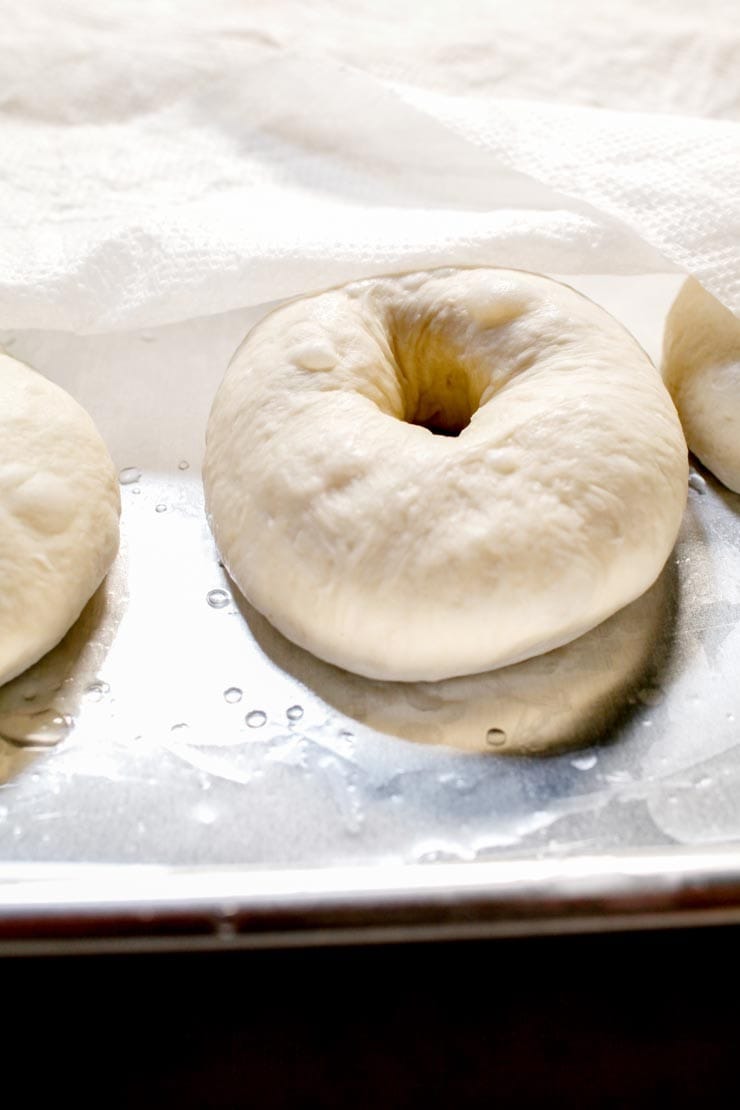
Shaping and Boiling the Bagels
There are many methods in which you can shape a bagel; there is a more traditional method that many bagel shops use– you roll the bagel dough into logs and bind the ends together.
The method used here is done by simply poking the hole in the middle of taught rounds of bagel dough. Once that is done, the bagel rings are gently stretched to about a third of the diameter of the bagel.
After a short rest, each bagel is boiled. This gives the bagels their New York-Style signature delicious, chewy, and shiny crust.
Read more: New York-Style Bagel Recipe FAQ located below the recipe section in this post.
While you can opt to flavor your poaching liquid (there’s more information about this in the FAQ section), I keep it simple here and just use water and these come out perfect every time.
The Bagel Toppings
Favorite bagel toppings vary from person to person. Depending on the day, I like a good homemade everything bagel or a poppyseed bagel. I know many people who are partial to single toppings like minced onion or coarse salt. Whatever you like, definitely customize the toppings to match your tastes.
Everything bagel seasoning, minced fresh garlic, minced fresh onion or shallot, poppy seeds, sesame seeds, caraway seeds, coarse salt, cinnamon sugar- these are just some of the many topping options you can go with to customize the taste of your bagels.
What to Serve the Bagels With
A proper New York-Style bagel always requires a schmear. What is a “schmear” you ask? It’s a generous slather of cream cheese. It’s practically a requirement, especially when these homemade bagels come out of the oven. However, there are multiple ways you can serve them– all of which I have listed within this post.
How to Make Homemade New York-Style Bagels
First, proof the yeast. Proofing basically means you’re activating the yeast. To do this, you will need to add sugar and yeast into luke warm water. After about 5 minutes, the yeast will bubble up; this indicates that the mixture is ready to stir until everything is properly dissolved.
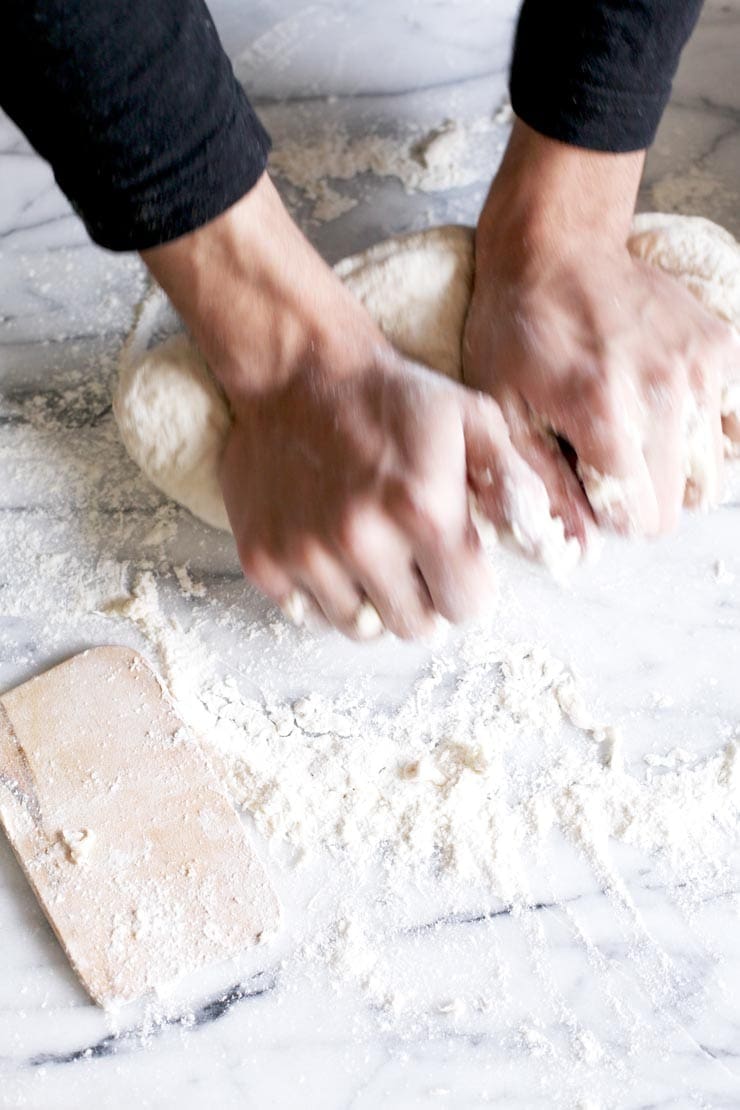
Then, mix the bagel dough together. You can you can opt to make the bagel dough by hand (which I highly recommend if you’re making this recipe for the firs time), or you can do so with a stand mixer fitted with the hook attachment, on the lowest setting (for about 5 to 6 minutes). If you’re making a double batch you might not be able to use your stand mixer for kneading– refer to your manufacturer’s instructions.
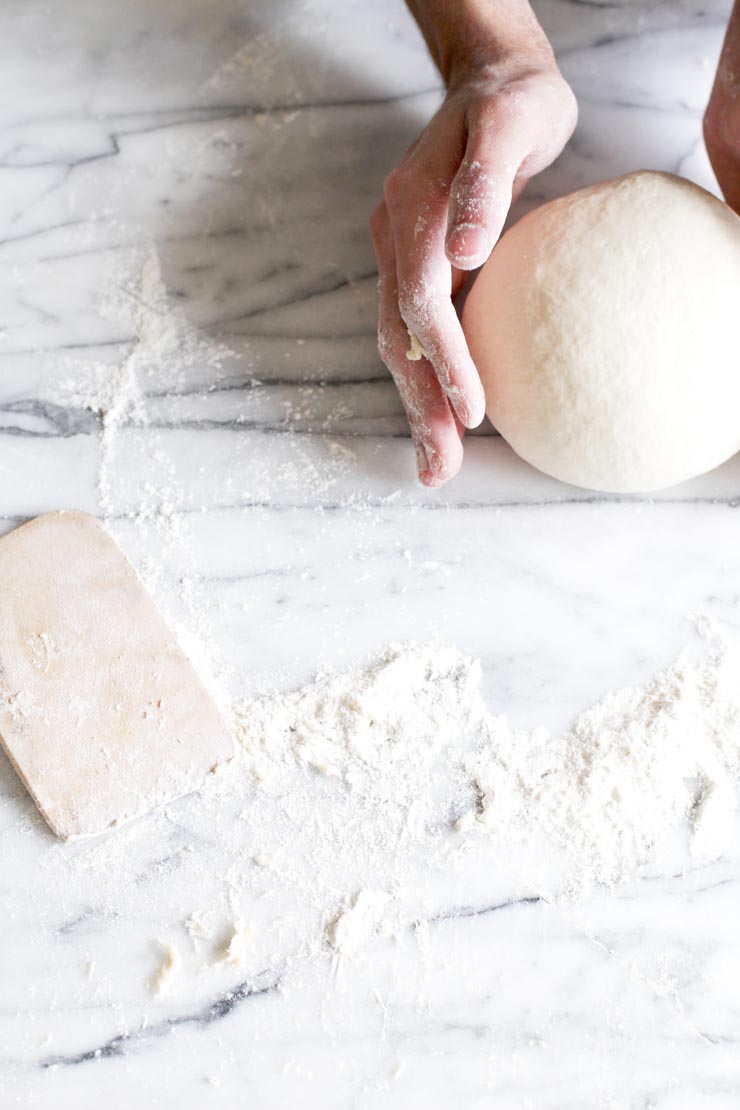
When mixing the bagel dough, you may or may not need the entirety of the water called for in the recipe. You want the bagel dough to be moist and firm after it is mixed. Sometimes you may need more water, depending on humidity, brand of flour, your altitude, climate, amongst many other things.
Once the dough has come together and has been kneaded, place the bagel dough in an oiled bowl to rest for an hour (about 2 hours if you’re using less yeast) or covered overnight in the refrigerator.
Once the bagel dough has rested, you will need to deflate it. You will know it has rested enough when you poke the dough with your finger and the impression remains. If it bounces back, the bagel dough has not risen enough.
If you allowed the bagel dough to rest in the refrigerator, allow it to sit at room temperature for about 1/2 hour before working with it.
Once deflated, divide the dough. It should be divided into 8 equal portions. Feel free to use a scale or eyeball it. You do not have to be exacting about this; just make sure they’re roughly even so that all the bagels bake at the same time.
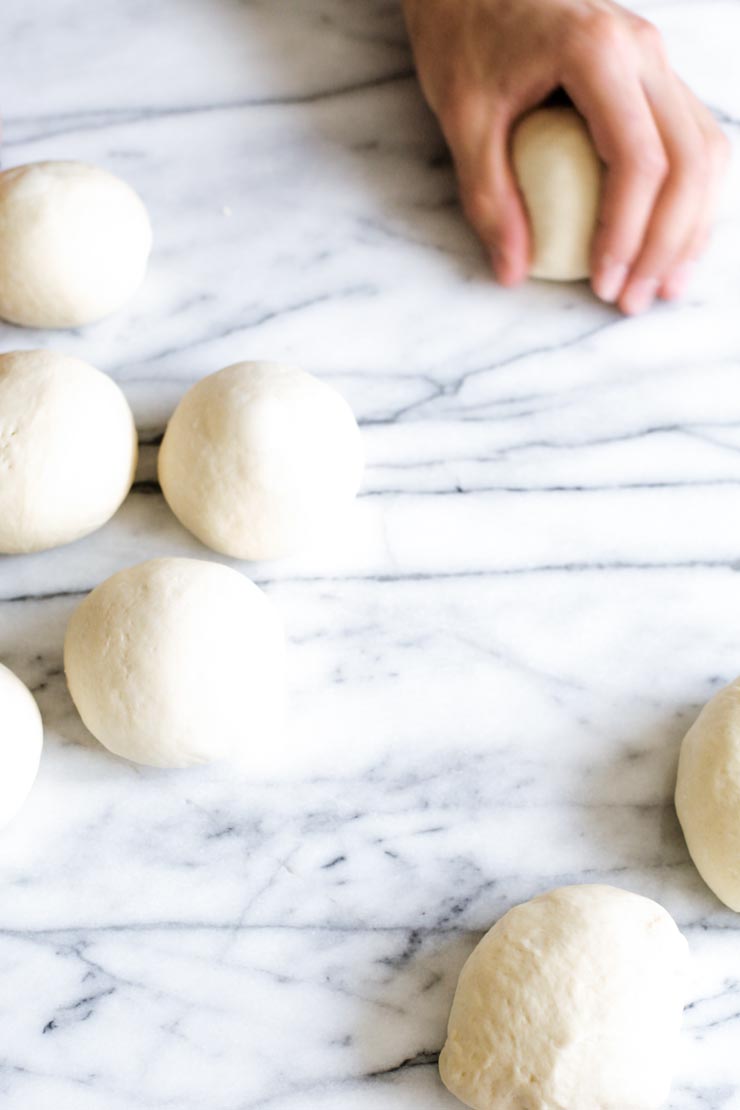
After that, form the bagel dough portions into rounds. Don’t use flour for this step. This is going to sound more complicated than it is, but hold your hand in a C shape while cupping a portion of dough.
Press the dough against the work surface (remember to avoid flouring it) and move your hand and the dough in a slow, circular motion. Allow the irregular edge of the dough to pull onto itself, while decreasing the pressure on top of the dough slightly until a perfectly smooth round ball forms.
Repeat this with the other portions. Have your eyes crossed? This probably does sound difficult at first, but essentially all you’re doing is making the dough round taut by pulling its sides in and keeping it round.
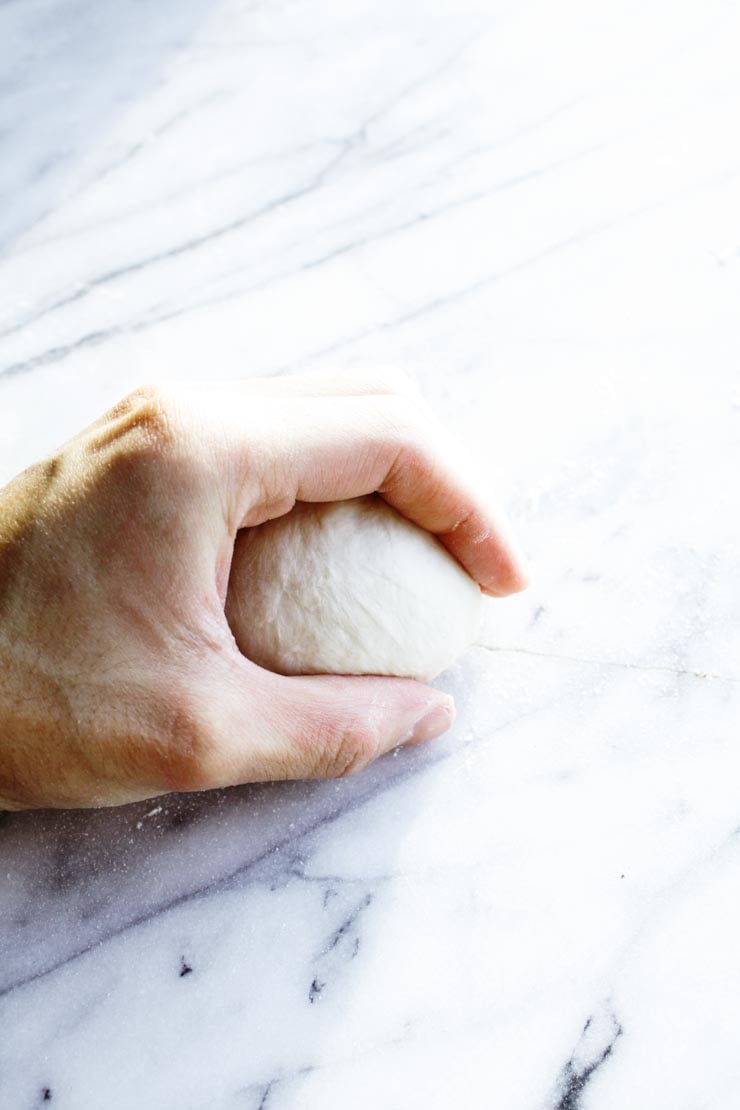
Now, here comes the part when we shape the bagel dough! Working gently and firmly with the dough will result in perfectly smooth bagels.
Simply coat a finger with flour and gently press your finger into the center of each dough ball. Then you stretch the rings out to about a third of the diameter of the bagel and place them onto a prepared baking sheet.
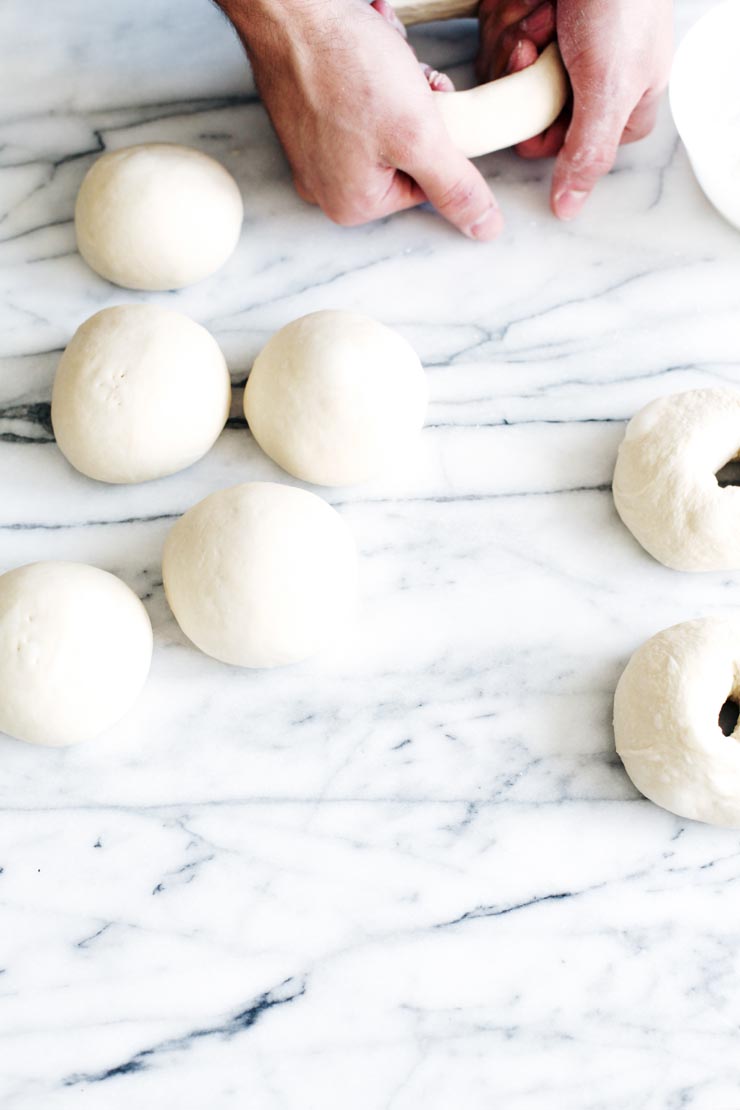
It’s time to boil the bagels. The bagels need a little rest in between shaping and boiling. So, while the unbaked bagels rest, bring a large pot of water to a bubbling boil.
Once it has reached a boil, lower the heat to a simmer. You’ll need a slotted spoon or a skimmer to place the bagels into the water. Some folks like to use small squares of parchment that they cut up before hand. Do what is most comfortable for you.
Handling the uncooked dough with the utmost care will preserve their shape as well.
Boil the bagels and don’t overcrowd the water. Boil as many bagels as you can comfortably fit into the pot. They will puff up quite a bit, so do keep in mind they do need some breathing room.
Once in the water, the bagels will float on the top. Let them sit for 1 minute, then gently flip them over to boil for another minute on the other side.
This will give them a nice crust and their signature New York-Style chew. You can go a little bit longer on the poach, as well. This will give them a stronger crust and chew– more on that in the recipe.
After boiling them, top the bagels! This is the time when you can let your creativity run free. You can use any or all of the topping options listed in the recipe.
Often times I do a combination of toppings to make a delicious homemade everything bagel. Sometimes I just keep it plain or stick to one ingredient on each bagel. Be creative!
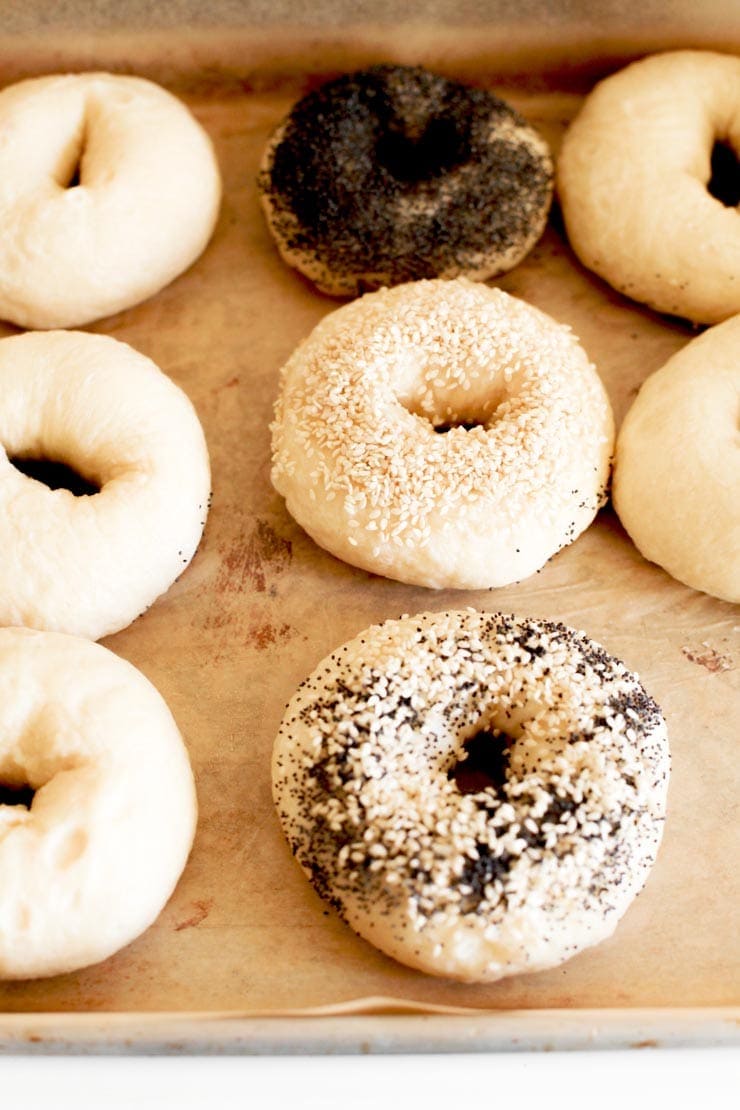
Once the bagels have been topped, bake them. Depending if your oven is calibrated or not (I like to keep an oven thermometer in mine to ensure it’s always accurate), you will need to bake the bagels between 20-25 minutes. Until they’re uniformly golden brown.
Now, here is the difficult part (not really). You’re supposed to let these cool for at least a few minutes once they’re out of the oven, until you can handle them. If you’re impatient like me, I brave through it, slice one open and schmear some cream cheese on mine right away.
Take a bite… Oooh, child!
Homemade New York-Style Bagel Serving Suggestions
There is no right or wrong way to eat a bagel. However, I’ve listed a few ideas and classic options you would enjoy. A schmear is a classic.
A bagel with lox is also another classic. If you’re looking for a good breakfast idea, go the New York City deli route and make yourself an Egg and Cheese Bagel. Bacon is preferred, but optional.
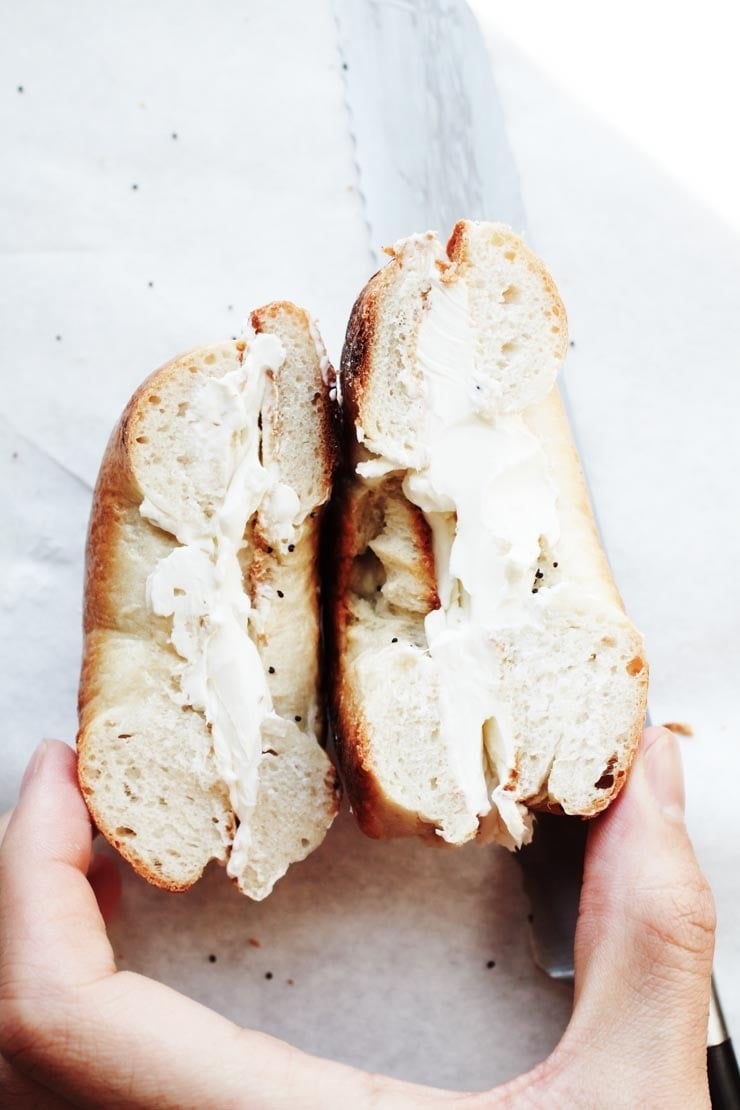
• Bagel with cream cheese– either plain, or your choice of flavored cream cheese. A schmear is a New York classic, and it’s so good.
• Bagel with butter– especially with homemade butter or a delicious French butter. Heavenly.
• Bagel with butter and jam– more specifically homemade butter and homemade strawberry jam– a match made in heaven. Highly recommended!
• Bagel with lox– add a schmear of cream cheese, lox on top, a slice of fresh tomato, red onion, thinly sliced cucumbers, and some deliciously briney capers. Perfection.
• Bagel with Avocado– a nice, healthy option. Toast the bagel, smash a ripe avocado on top, season to your liking, and serve it. Bacon is perfect on top, if you’re into that. Leftover guacamole is also delicious.
• Bagel with Egg and Cheese– this is New York City deli / bodega-style, peeps. Toast the bagel. Butter it lightly. Make an egg and cheese omelet to your liking. Or fry an egg up, over easy, season it with salt and pepper, top it with cheese and bacon. Add ketchup, if you’re into it. If not, add aioli, hot sauce, sriracha, sambal olek, or a combination thereof if you’d prefer that. Cut it in half. You’ll thank me later.
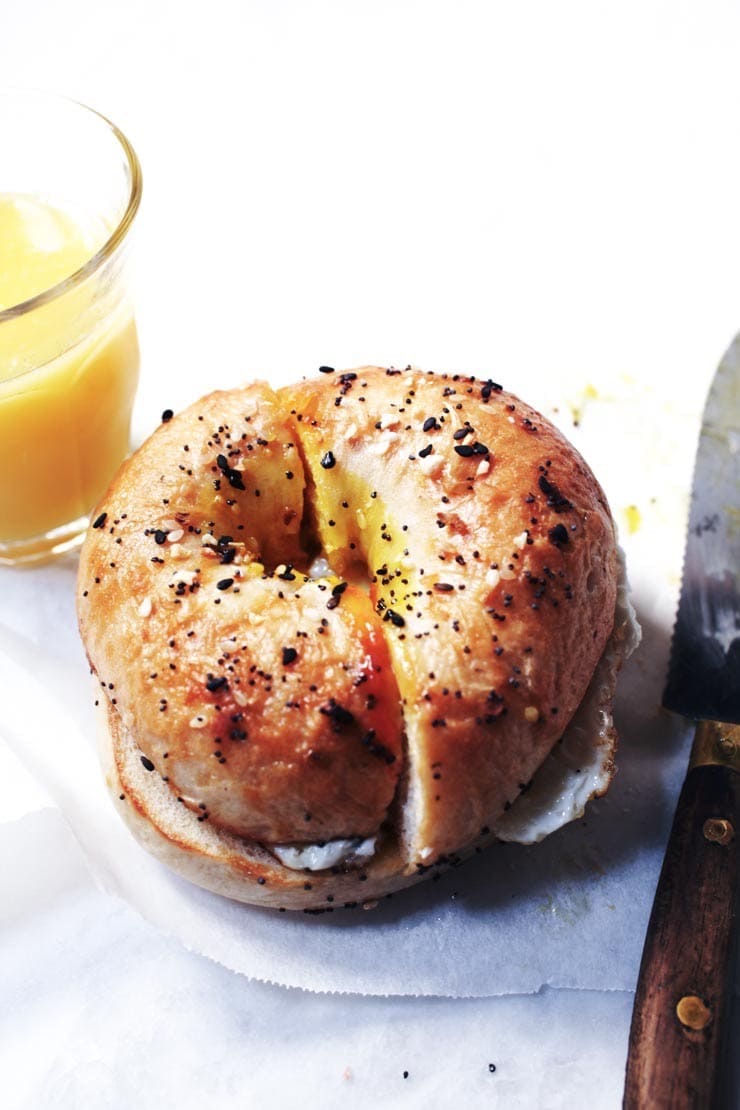
More Everyday Baking Recipes
- New York-Style Soft Pretzels
- Cinnamon Sugar Soft Pretzels
- Perfect Chocolate Cupcakes
- The Best Raspberry and Cream Scones
- Incredible Profiteroles
- Strawberry Pavlova
New York-Style Bagel Recipe

As a native New Yorker, I know there's nothing better than a fresh bagel schmeared with cream cheese. I no longer live in New York City, and I constantly crave the good old-fashioned bagels I grew up on– flavorful, modestly sweet, chewy ones with soft, shiny crusts.
These bagels are made the classic way: You boil them in water for a couple of minutes before you bake them. This is probably one of the most bizarre things a person can do to the dough, but it works. So, if good bagels cannot be found where you live, worry no more; this recipe is infinitely adaptable, and the little bit of effort you put into making these bagels is well worth it.
Ingredients
- 2 teaspoons / 6 g active dry yeast
- 4 ½ teaspoons / 19 g granulated sugar
- 1 ¼ cups / 300 ml warm water (you may need ± ¼ cup /60 ml more)
- 3 ½ cups / 440 g bread flour or high gluten flour (you may need up to 1/2 cup / 60g for kneading)
- 1 ½ teaspoons / 6 g salt
- Optional Toppings: (Refer to Notes)
Instructions
- In ½ cup /120ml of the warm water, pour in the sugar and yeast. Do not stir. Let it sit for five minutes, and then stir the yeast and sugar mixture until it all dissolves in the water.
- Mix the flour and salt in a large bowl. Make a well in the middle and pour in the yeast and sugar mixture.
- Pour 1/3 cup / 80ml of warm water into the well. Mix and stir in the rest of the water (the scant 1/2 cup / 100ml that is remaining), as needed. Depending on where you live, you may need to add an additional couple tablespoons to about ¼ cup/60ml of water. You want a moist and firm dough after you have mixed it.
- On a floured countertop, knead the dough for about 10 minutes until it is smooth and elastic. Try working in as much flour as possible to form a firm and stiff dough.
- Lightly brush a large bowl with oil and turn the dough to coat. Cover the bowl with a damp dish towel. Let rise in a warm place for 1 hour, until the dough has doubled in size. Punch the dough down, and let it rest for another 10 minutes.
- Carefully divide the dough into 8 pieces (I used a scale to be extra precise, but it’s not necessary). Shape each piece into a round. Now, take a dough ball, and press it gently against the countertop (or whatever work surface you’re using) moving your hand and the ball in a circular motion pulling the dough into itself while reducing the pressure on top of the dough slightly until a perfect dough ball forms (as pictured). Repeat with 7 other dough rounds.
- Coat a finger in flour, and gently press your finger into the center of each dough ball to form a ring. Stretch the ring to about ⅓ the diameter of the bagel and place on a lightly oiled cookie sheet. Repeat the same step with the remaining dough.
- After shaping the bagels and placing them on the cookie sheet, cover with a damp kitchen towel and allow to rest for 10 minutes. Meanwhile, preheat your oven to 425ºF / 220ºC / Gas Mark 7.
- Bring a large pot of water to a boil. Reduce the heat. Use a slotted spoon or skimmer to lower the bagels into the water. Boil as many as you are comfortable with boiling. Once the bagels are in, it shouldn’t take too long for them to float to the top (a couple seconds). Let them sit there for 1 minute, and then flip them over to boil for another minute. Extend the boiling times to 2 minutes each, if you’d prefer a chewier bagel (results will give you a more New York-Style bagel with this option).
- If you want to add toppings to your bagels, do so as you take them out of the water. Alternatively, you can use an egg wash to get the toppings to stick before baking the bagels. You may want to use the “Optional Toppings” listed above to top the bagels. Use just one topping, or a combination to make your own Everything Bagel Seasoning.
- Once all the bagels have boiled (and have been topped with your choice of toppings), transfer them to an oiled or parchment-lined baking sheet.
- Bake for 20 - 25 minutes, or until golden brown (I usually err on the side of 20 minutes).
- Cool on a wire rack (Or, if you’re impatient like I am, slice one of these babies open and spread on some of your favorite cream cheese or softened butter. Take a bite… Oh babyyy!)
Notes
Optional Toppings:
Caraway seeds, cinnamon sugar, coarse salt, minced fresh garlic, minced fresh onion, poppy seeds, sesame seeds, everything bagel seasoning, or a mix of your favorite flavors.
Water measurement & similar concerns:
The recipe measurements for the water in the recipe is a guide; not all 1 1/4 cups (300 ml) will be used unless you need it. This is because of environmental factors (humidity, temperature, altitude, etc.) and the flour you are using. The most important thing when making the dough is to make sure it is homogenous and smooth– do not get caught up on the water measurement. If the dough is too firm, add in more water to ensure the dough is not dry and flaky– this has to be done when mixing the dough, not after you’ve allowed it to rise.
For all other concerns, please review past comments and refer to the FAQ below the recipe card for this recipe.
Nutrition Information:
Yield:
8 Medium-Sized BagelsServing Size:
1 BagelAmount Per Serving: Calories: 228.4Trans Fat: 1.4gCholesterol: 0mgSodium: 441mgCarbohydrates: 44.4gFiber: 1.7gSugar: 2.4gProtein: 6g
New York-Style Bagel Recipe: Frequently Asked Questions (FAQs)
The following is a comprehensive list of Frequently Asked Questions I receive about this New York-Style Bagel Recipe. You will find answers to your questions about Yeast, types of flour you can use, and everything you may need to keep in mind when it comes to preparing this homemade bagel recipe and storing the bagels properly.
The Yeast
Can I use fresh yeast?
If you are unable to get active dry or instant yeast, you can use fresh yeast. The general rule of thumb is a ratio of 2.5:1, fresh to active dry. The amount of active dry yeast used in the recipe is only 6 grams, you would need about 15 grams of fresh yeast.
When substituting fresh yeast, you may want to make a few adjustments to the method. Fresh yeast does not need to be proofed like active dry yeast. The water, sugar, and yeast step will be unnecessary in this case, so do keep that in mind. But, as some have told me, they’ve simply substituted fresh yeast for the active dry yeast and followed the steps as directed without any issues.
Can I use instant yeast for this bagels recipe?
You can. Substitute an equal amount. There’s no need to proof the yeast, so add the yeast to the flour with the sugar and jump straight to making the dough.
I prefer less of a yeasty bread-like flavor, how can I achieve that?
You can reduce the amount of active dry yeast to 1 teaspoon in the recipe. Do note: you will have to double the rising time to about 2 hours, instead.
Types of Flour
What if I can’t find bread flour? Can I substitute regular (all-purpose) flour?
If you don’t have access to bread flour, it is okay to use all-purpose flour; they will still come out wonderfully. Alternatively, if you can find vital wheat gluten (it’s usually carried at health food stores), add 4 teaspoons to the all-purpose flour, and you should have a good substitute for the bread flour called for in the recipe.
• Can I make bagels with whole-wheat flour?
Yes, simply use half whole-wheat flour and half bread flour. If you like a milder tasting bagel, you can use white whole-wheat flour.
• Can I use spelt flour for bagels?
Yes. Use 2 cups / 255 g whole-wheat flour and 2 1/2 cups / 315 g sifted spelt four. Alternatively, readers have told me that they’ve made the bagels entirely out of spelt flour with great success.
Preparation
How hot should the water be to proof the yeast?
The water should ideally be between 105F / 40.5C – 115F / 46C.
Can I prepare the bagel dough in my bread maker or KitchenAid / stand mixer?
You can absolutely use either. For a stand mixer: use the hook attachment, and knead the dough on the lowest setting. Do this for 5 to 6 minutes until smooth and springy. If you’re making a double batch, you might not be able to use your stand mixer for kneading. Please refer to the manufacturer’s instructions.
My bagels aren’t smooth. What did I do wrong?
There’s two factors that come into play here: the way the dough is handled and the water the dough is boiled in. Being gentle is crucial to the formation of smooth looking bagels. The less you handle it, the smoother it will be. If you squeeze the dough roughly, it’ll turn out wrinkly. Like many folks, I bake these bagels a lot, and some batches come out smooth and gorgeous, and on bad days some come out wrinkly. It’s all about how you handle the dough, but in the end- it always tastes amazing!
When it comes to boiling, make sure the water is not at a rolling boil. This will also prevent them from looking rough.
How can I achieve an even shinier, sweeter bagel? Can I use barley malt or honey?
Yes! This will achieve a slightly sweeter and shinier product. Use about 1 teaspoon of barley malt in the dough and a generous tablespoon in the pot of boiling water. Because barley malt is not easy to find, I have not made it a required ingredient for the recipe. However, it does add a delicious taste. Alternatively, you can use a couple tablespoons of brown sugar and/ or honey in the boiling water to achieve a similar effect.
Do the bagels need an eggwash before they go into the oven?
No, an egg wash is not necessary, though it does give a beautiful sheen to the bagels. The bagels will be just as beautiful and delicious if you forego the egg wash. This is especially a great option for vegans.
Once boiled, add toppings to the wet, unbaked bagels immediately so that the toppings stick.
My bagels stuck to my pan. What can I do to prevent this in the future?
The original recipe calls for simply using an oiled pan (I’ve edited it). Like many folks, I am paranoid about things sticking to pans, so I use parchment paper or a silpat baking mat (as shown in this post). Feel free to do the same. I do oil the parchment just a bit to add a little bit of extra non-stick protection, but it’s not necessary.
I live at high elevation, what can I do to ensure these come out properly?
I’ve been told by bakers who live at a higher elevation that this recipe works well as is. However, I know that high-altitude baking, especially with yeast, can be a headache as dough tends to rise about 25 to 50 percent quicker than at lower altitudes, so do keep that in mind.
A sure-fire way to ensure that the finished product is not very dense would be to reduce the amount of yeast to 1 teaspoon and allow the dough to rise for the recommended time in the recipe. If the dough has doubled in size after 1-hour, it’s good to start working with. If not, continue to let it rise, checking on it every 15 minutes until doubled in size. Your altitude, brand of flour, humidity, and room temperature are factors that would make the rising times vary.
Can I make the bagels bigger?
You can, just keep in mind that they will need longer to bake. Check on them every few minutes past the 20 minute mark until they are uniformly golden brown.
Make Ahead and Storage
How can I make the dough ahead of time? Can I refrigerate the dough over night?
The best means of making the dough ahead of time would be to prepare it, cover its container with plastic wrap, and rest it over night in the refrigerator. This is called a cold-rise. I often do this and I love this method because it allows the dough to achieve a more complex flavor. If you are doing a cold rise, be sure to allow the dough about 1/2 hour to come to room temperature before working with it.
Can I par-bake the bagels for later baking?
Yes, you can bake them until they are a faint gold tinge (about 10-15 minutes). Cool the par-baked bagels completely before storing them in a resealable bag to be stored in the freezer. To be bake from frozen, bake the bagels for an additional 10-15 minutes, until soft and golden brown.
Can I freeze the bagels? Do they keep well?
Once cool, out of the oven, you can freeze the bagels without any issues. Slice them and then freeze them in a freezer-safe plastic bag, and let them thaw when needed. If you’re planning on toasting them, thawing them is unnecessary.
How long do the bagels stay fresh for?
The bagels will keep in a resealable plastic bag at room temperature for up to 2 days.
Updated May 14th, 2020 – As one of the most popular recipes here and in my book, I’ve received many questions about this bagel recipe. For your convenience, I’ve updated the post with photos, more information, and answers to your Frequently Asked Questions.
Have another question? Leave a comment below!
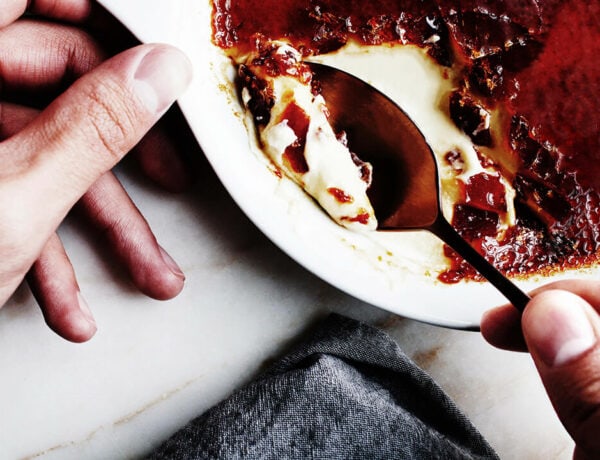
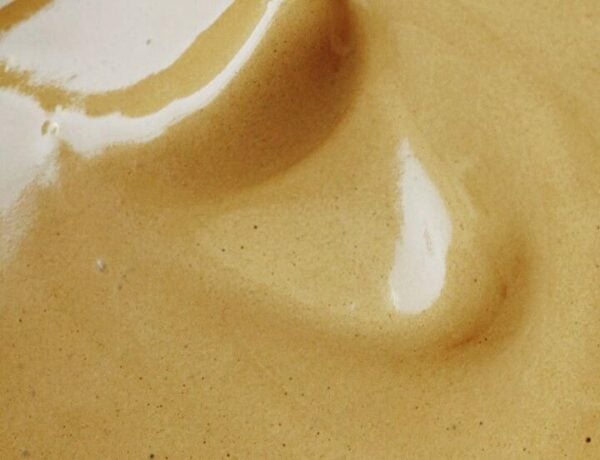
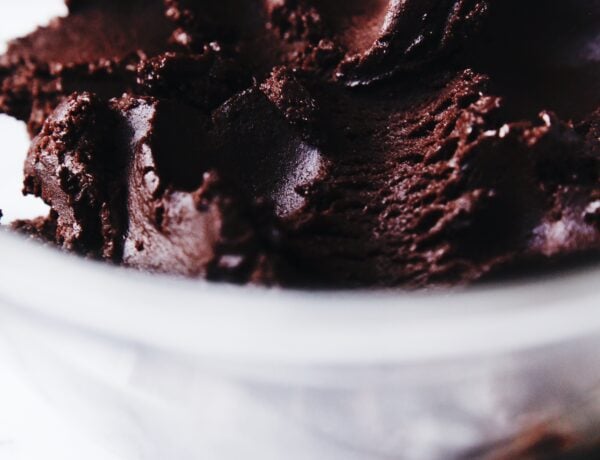
1,518 Comments
Caroline
May 23, 2020 at 7:04 pmI learned the Jo Goldenberg recipe in high school, but I love that this one is a little simpler yet absolutely delicious! I made the dough the night before, and it took about an hour and a half in the morning to make, including the recommended 30 min for the dough to come back to room temperature. Boiled for 2 min each side and the bagels were amazingly chewy on the outside and fluffy in the middle. Made a few with the Trader Joe’s Everything but the Bagel seasoning blend and Furikake, service with cream cheese, smoked salmon, sliced salted shallots, and capers or egg and cheese with heirloom tomatoes.
What a great Saturday morning treat for all of us. Thank you for this recipe, Kamran. Great introduction to your website and I look forward to trying more of your recipes.
SethG
May 24, 2020 at 3:45 pmHi! First time trying this recipe and it’s great. I do like my bagels a bit denser though– do you have any tips on how to achieve that? I’m a my transplant living in California so that’s like the last step I need to get a perfect long island bagel experience ;).
Kamran Siddiqi
May 25, 2020 at 4:27 amHi SethG- You’ll need to slowly work as much flour as possible into the dough when kneading it, as mentioned in the recipe. If it gets too dry, sprinkle on some water and keep kneading. It’s easier to do with a stand mixer as you can mix in a tablespoon at a time while the mixer does all the work. But definitely getting a feel for the dough is very gratifying and will help you determine if you need to add more flour or not.
David Ramirez
May 24, 2020 at 5:57 pmI love the recipe, I have made them twice, I am having problems making them truly round, but I am determined to keep trying. Any suggestions would be greatly appreciated.
Kamran Siddiqi
May 25, 2020 at 4:23 amHi David- Pinching all the corners together and then rolling them as pictured (and shown in the video) should help. Just make sure you aren’t flouring the surface… You need the dough to be a bit tacky so that it becomes round and taught.
Lynn
May 24, 2020 at 7:17 pmHi! Any tips for getting sesame seeds (or whatever) on both sides of the bagel? Will they burn on the bottom?
Kamran Siddiqi
May 25, 2020 at 4:21 amHi Lynn, they might get a little darker on the bottom, depending on the color pan you use, how your oven runs, etc. so I would use a silpat if you have one, or two sheets of parchment paper and maybe bake them on a rack just one step above from being in the center of the oven. If after about 15 minutes, they’re looking too dark, move them to the top rack of the oven to finish baking.
Lucas
May 25, 2020 at 4:16 pmHi! This recipe is fantastic, thank you so much. A friend of mine made it and shared it with me, and my girlfriend and I just had wonderful day spent making these. I do have a quick question — is there a way to make these without using yeast (letting the dough ferment naturally, like you could with sourdough) and only using flour, water, and perhaps some salt?
Patty
May 25, 2020 at 4:28 pmThese were excellent. Thanks so mush for all the hints and tips. We really enjoyed them and my bagel picture got rave reviews on Instagram.
Jennifer
May 26, 2020 at 9:44 pmSadly, my bagels have zero taste. I thought I would let the dough rest overnight in the fridge because I really wanted tons of flavor. I followed the recipe exactly. I tossed in Everything seasoning and baked for twenty minutes which was not enough. I put in for an extra seven minutes, and some of the bagels were still raw. This could be because I am in Aspen. When I tasted one that was not raw, while the crust is crusty, the dough inside has zero flavor. I do not think I’ve ever tasted anything without any flavor before. After all of your outstanding reviews I was hoping to have a delish bagel as a good bagel in Aspen is non-existent. I am happy I tried it. Now I know how to do it, and will continue to try to figure out how to make them. Thank you for your recipe!
Kamran Siddiqi
May 27, 2020 at 5:23 pmJennifer – I’ll try to address all your concerns here, but if you have any other questions, definitely shoot me an email! This recipe has been tested and made thousands of times, so I’m afraid being in Aspen is most definitely a contributing factor to the outcome of much of the baking you will do, whether it’s this recipe or not as you’re at a higher altitude… There is enough salt in the recipe to add flavor; I recommend using fine-grain sea salt for baking. Kosher salt won’t cut it if you’re using that– the grains are too big for baking, so please keep that in mind if you are using anything else. This post and all of the information here and in the video is filled with information to successfully make this recipe; you definitely want to drain the bagels once they are out of the water, otherwise you’ll end up with gummy centers. I recommend using an oven thermometer as well as most ovens are never truly calibrated, which is why baking times vary from person to person (altitude being one of the contributing factors as well). What might take me 20 minutes will take you 25 or longer. It’s why baking times in any recipe are simply meant as a guide. In regards to high-altitude baking, please check out the following Epicurious article about High Altitude Baking Tips. I think it will really help you with any future baking you will do in Aspen. I hope all of that helps, and I hope your next batch is a success!
Jas
May 26, 2020 at 10:38 pmSOOOOOOOOOOOOOOOOO DEEEEEEEEEELIIIIIIIIIIIIICIOUS!!!! I put mayo, egg, bacon and cheese, it tasted better than the NYC Benedict bagel where I live!
One problem tho… I don’t know what I did wrong, because the outside of all of my bagels were rock hard, still edible and delicious, but really hard on the outside. I followed your recipe EXACTLY, and it even came out looking like yours looked in the photo. What could I have done wrong, and how can I achieve a soft, chewy bagel?
Kamran Siddiqi
May 27, 2020 at 5:07 pmHi Jas- there could be many contributing factors; it might’ve been you rested them too long after they were shaped or didn’t poach them long enough. Conversely, they could’ve been poached them for too long. You don’t want the water at a rolling boil.
Ellen Blanchard
May 27, 2020 at 4:33 pmTwo questions on variations:
1) Can I mix in raisins and cinnamon before shaping into rounds?
2) Could I use rye flour to make Pumpernickel bagels?
Kamran Siddiqi
May 27, 2020 at 5:01 pmHi Ellen – You can add them to the flour before mixing the dough; it’ll probably be easiest. As for the pumpernickel bagels– you can; if you can get your hands on “whole rye flour” or “pumpernickel flour,” that would work best.
Anya Fidelia
May 28, 2020 at 1:29 amThank you so much for the recipe – so delicious! I have a question for my next try: I made the dough with nutritional yeast, brown sugar, and all purpose flour- according to your recipe. I put the dough in a stainless steel bowl covered by plastic wrap into the fridge overnight, and baked them toward the end of the next day (about 24hrs later) in a convection oven. I let the dough sit in room temperature for a long while after taking it out of the fridge (about 2 hours). When I put the shaped bagels into the boiling water, the bagels didn’t float to the top at all, and also didn’t expand very much, turning out quite flat after I have baked them in the oven. We all loved the taste nonetheless, but I am wondering where did I go wrong? how can i make sure the bagels raise better next time? `
Kamran Siddiqi
May 28, 2020 at 5:29 amHi Anya- my recipe does not include nutritional yeast, brown sugar, or all-purpose flour (though the flour is an acceptable substitute if you can’t find bread flour). I understand yeast and flour are hard to come by right now, however, nutritional yeast is not meant as a substitute for yeast used for making bread. Nutritional yeast adds a nice flavor, but will not make dough rise, which I think is why you had so many problems making the recipe. If you can get yeast meant for baking bread, I think you’ll have successful results next time!
Anna
May 28, 2020 at 3:05 pmThird time’s a Charm! I live at very very high altitude and had 2 failed attempts as I didn’t read all the notes. Today I halved the yeast and rising time and they are almost
Perfect! I Am so grateful to be able to make my own bagels now! Thank you!
Kamran Siddiqi
May 28, 2020 at 4:00 pmAnna – My pleasure! Glad it worked out for you. There’s a lot of notes for this recipe, but it’s definitely worth reading to achieve the ultimate bagel experience. Happy baking!
Alicia
May 29, 2020 at 10:51 amCan I use 00 flour? I can’t find bread flour anywhere! Thank you!
Kamran Siddiqi
May 30, 2020 at 3:06 pmAlicia- If that’s all you have on hand, it should work!
Amanda
May 30, 2020 at 3:33 amOk, round 2! Second attempt in less than 24 hours since we devoured the entire batch I made last night and didn’t have any for breakfast today. Last night I prepped a second dough and popped it in the fridge after the bulk rise. This am, after 30 minutes of bringing to room temp, I followed the rest of the recipe. Since yesterday’s we’re a bit wrinkly, I decided to add a sprinkle of baking soda to the water bath (since it works so well on my pretzels). Today’s were glossy, golden brown, and wrinkle free! Yay! I used them to make sausage, egg, and cheeses. Saltpeppaketchup and it was a taste of home, half a planet away. Thank you!
Vanessa
May 30, 2020 at 7:08 amHi, just wondering how much water do I have to add to the flour? The ingredients stated 300ml but in the steps, it was 120ml in step one and 80ml in step 2 which is a total of 200ml. It’s a bit confusing. Can you clear this up? Also, if I knead the dough in the kitchen aid, do I have to knead it again by hand? Thank you!
Diane Feitelson
May 30, 2020 at 10:48 amWill gluten free flour work in this recipe? Would I need to make any other changes. Thank you.
Kamran Siddiqi
May 30, 2020 at 3:02 pmI’ve seen a few people on instagram make the recipe with gluten-free flour and it comes out beautifully. You might have to make adjustments as this is not a gluten-free recipe, so keep that in mind.
JENNIFER H KELLY
May 30, 2020 at 5:23 pmI made mine in my bread machine! It took a bit longer, but I was able to go about my business while they were mixed and raised in the machine. I punched down the dough, and followed the directions for the rest. They were great! Very happy with the results!
Jane Dough
June 1, 2020 at 8:16 pmI’ve made these three times, and they just keep getting better! This time I doubled the recipe but used 3TS of instant yeast and it worked perfect! I made half sesame seed and half Asiago cheese. The Asiago I shredded and kneaded in right before the final rest when I shaped the bagel. Sooo good!!
Kat
June 2, 2020 at 1:41 pmCan I use instant yeast? I wanted to make bagels for my mother and all I can find right now is instant yeast. If so how does that change the recipe, if at all?
Kate
June 2, 2020 at 2:25 pmI just made these for the second time. The first time they didn’t come out great but then I read the comments. I made sure I kneaded as much flour as I could, each ball was 10g more than the first round. I also used a silicone mat instead of parchment paper and the bottoms didn’t burn. This second round I made the best bagels I have ever had. So chewy and delicious. I use Two Peas and Their Pods’ Everything Bagel Seasoning (I make it in bulk and put it on EVERYTHING). Get the flaked sea salt, it’s the best. Anyway, this recipe is sooo good, thank you!
Jessica
June 3, 2020 at 7:40 amI am an American living in the UK and the bagels here should be considered criminal. I have made a few recipes from scratch previously, but there was always something a bit off. I came across your recipe and decided to make a half batch. My husband and I burnt our hands devouring these fresh out of the oven. They are incredible! I am back today to make a full batch. I am never buying bagels in the UK again. I left my bagels in the hot water for 2 minutes a side and it had the perfect amount of bite on the outside that I love in a bagel. I found the recipe to be very easy. Going to try making a few cinnamon sugar bagels on this round. Thank you!!
Robin
June 3, 2020 at 4:51 pmI bake these weekly while quarantined and I love them sooooo much. I sub out about 1/3 of the flour with rye flour and knead for about 3-4 minutes versus 10 by hand as they were getting pretty dense the longer I kneaded. Thank you for making bagels accessible to the common baker!!!
Jen
June 4, 2020 at 1:57 pmHello! I just wanted to thank you for this wonderful recipe! I’m a gluten-free food blogger with celiac disease and I made a modified version of these with Cup4Cup gluten-free flour and they turned out amazing! As a native New Yorker, I’ll do anything for my bagels. Thank you for this!
Michelle
June 6, 2020 at 7:21 amI have diastatic malt powder and not Barley Malt syrup. How much of it should I use in the dough and water bath?
Kamran Siddiqi
June 7, 2020 at 4:51 amHi Michelle- I would use about 1 teaspoon in the dough. I wouldn’t use it for the water bath though.
mala
June 7, 2020 at 4:15 amHello ! I just baked these bagels and they are amazing. I do lots of baking and truly this will go to my baking book.Thank you
Leah
June 7, 2020 at 10:07 amWonderful recipe! Simple, straight-forward, and easy to customize. Have used this recipe with all-purpose, bread flour, 1/2 all purpose 1/2 whole wheat… it turns out great every time. Have tried incorporating ~2 tbsp of za’atar spice blend into the dough and it is delicious!
Melissa
June 7, 2020 at 4:22 pmI followed the recipe exactly and topped with Asiago. My bagels didn’t brown after baking 25 min. Any advise?
Kamran Siddiqi
June 17, 2020 at 2:08 amMelissa- You might just need to bake them longer. Everyone’s oven temperatures vary and often times home ovens are not calibrated to the correct temperatures / do not actually preheat to the correct temperature even though your oven will tell you otherwise.
Angela M Francis
June 8, 2020 at 2:06 pmI’ve been using this recipe since 2015. I still remember the first batch I made, and being surprised at how well it turned out. I do seem to have trouble making the top smooth out of the oven. Mine comes out bit wrinkly on top, and wondered if there is a trick to making them perfectly rounded and smooth top out of the oven? Thanks.
Claire
June 8, 2020 at 9:27 pmSo I made these and they tasted fantastic – but my bagels deflated after I boiled them. They were nice and fluffy before I boiled them, but once I took them out of the pot and placed on the baking sheet they just totally deflated! Not sure what I did wrong, but would love some advice for the future! They’re still super tasty though!
Linda Monroe
June 9, 2020 at 5:31 pmThis recipe makes the most scrumptious bagels! They were fun to make but I have not perfected the smooth surface yet.
I enjoyed one right out of the oven. Do you have a recipe for cinnamon raisin bagels?
Ron Awde
June 10, 2020 at 1:44 pmAs far as using diastatic malt in the dough, I found that it works best to use a bit of the water and dissolve between 1 and 3 teaspoons (depending on how sweet you like the bagels) before mixing it in.
Susan Ras
June 11, 2020 at 4:12 pmI have made these bagels many times and they are a huge hit with my family. I’d like to try to do the overnight rise in the refrigerator as I want to boil and bake them early tomorrow morning. Hold my hand here please!! At what point in the recipe directions should I put the bowl in the fridge? After all the punching and kneading? Should I punch and or knead it in the morning before separating the dough?
Kamran Siddiqi
June 12, 2020 at 1:16 pmHi Susan – Step 5. So, instead of letting the dough rise at room temperature, let it rise in the refrigerator overnight. The next day, let it sit for about 1/2 an hour at room temperature before punching it down and working with it.
Amanda
June 12, 2020 at 9:05 pmThis recipe was great! They came out perfect the first try, I couldn’t believe it. I’m going to try again and make a smaller bagel, maybe 12 bagels instead of 8. I’m not sure if I should lower the temperature and the baking time, or just bake for less time. Thanks for the recipe and great details!
SC
June 13, 2020 at 2:09 amHi Kam,
I made it! This is my first attempt on bagels. They are delicious. I think I need to balance the amount of water and flour here of the final stage of kneading. My final resting sees the round doughs developed a layer of skin although I did cover them with kitchen towel. I wonder if I need to tweek to increase water content and not add anymore flour. Basically I added 40ml of water and 20g of flour at the final kneading stage… This makes the entire water content to be 240ml and flour of 460g (tried packing more flour here…). Any comments for this %? Thank you so much for the simple and achievable recipe!!!
Kamran Siddiqi
June 17, 2020 at 1:59 amHi SC- I think the issue here isn’t your water to flour ratio when making the dough. I wouldn’t get too caught up on this as the dough to flour ratio varies from person to person and day-to-day due to various environmental factors… If the dough comes together nicely and is smooth and firm, there is no need to force the dough to absorb any extra flour than necessary. One tip I can offer you would be to dampen the kitchen towel some more or to use plastic wrap (cling film) instead to create a moist environment for the dough rounds to prevent a dry skin from forming. I hope that helps!
Nancy
June 14, 2020 at 9:19 amThis is my second time making these bagels. The first time they had taste this time they didn’t. After boiling they seemed plump but one seasoned with sesame seeds and baked they seemed to sink….nothing like the pictures. Any ideas as to what I did wrong.
Kamran Siddiqi
June 17, 2020 at 2:07 amHi Nancy- It sounds like you might’ve forgotten the salt in the recipe and your yeast was not properly proofed / the dough did not rise long enough. When preparing the yeast, water, and sugar mixture, ensure the water is luke-warm (notations about this can be found in this post). Also, ensure that your yeast is not expired. If the yeast foams up a bit while sitting, it is alive. It will foam further when you melt the yeast into the water after about 5 minutes. When the dough is puffy and holds an impression after you have let it rise for about 1 hour (this depends on your environment; it can take less time or more), that means the dough has properly risen. If the dough has not properly risen, you will end up with bagels that sink to the bottom of the pot. Rushing the process will not be of any help. One suggestion I offer for many bagel makers is to do a cold rise over night. Prepare the dough the night before you plan on baking your bagels. Allow the dough to rise in the refrigerator overnight. Once you’re ready to work with the dough, allow it to sit at room temperature for about 1/2 hour before deflating it to work with. This will enhance the flavors of the dough and make an even more fantastic bagel.
ellie struthers
June 14, 2020 at 7:39 pmHi! I have a question. I was wondering when I make the bagels the day before baking them and refrigerate them overnight – what step would i stop and put them in the oven? For example, would I boil them the day before and then put them in a container or would i do that the day of?
Lora
June 15, 2020 at 6:55 pmWill adding glutinous rice flour make the bagels a bit chewy?
Kamran Siddiqi
June 17, 2020 at 1:52 amLora- I wouldn’t suggest using glutinous rice flour to this recipe; it would change the chemistry of the bagels.
Fay
June 17, 2020 at 2:49 pmI can’t for the life of me find the video, the link at the top keeps looping me back to this page. Is the video tutorial still up somewhere?
Kamran Siddiqi
June 17, 2020 at 3:09 pmHi Fay – If you are having difficulty viewing / finding the video, please ensure your ad blocker is switched off as the video will not load within the post.
Caitlin
June 19, 2020 at 1:51 pmHi I’m thinking of making these soon. Just wondering if by cane sugar do you mean demerara sugar? because I have loads of it and nothing to do with it and will it affect the texture or taste?
Badri N
June 19, 2020 at 3:01 pmAwesome recipe! Was wondering if this would work if I mixed in shredded cheddar cheese and chopped jalapenos with the dough… I love a good jalapeno-cheddar bagel!!! Any experience or tips?
Thanks again!
Jack
June 20, 2020 at 3:29 pmHoly smokes. These are fantastic. Remember to decrease the yeast somewhat if you live at very high altitudes.
Shuku Anderson
June 20, 2020 at 7:22 pmThank you so much for the amazing recipe, have made them 3 times already and my family/friends are obsessed. I would like to use up some rye flour when i make them tomorrow, please could you suggest how I should do this?
Thank you! X
Hannah
June 20, 2020 at 8:06 pmThank you for this recipe! I find it so hard to find good real bagels in Sydney. I want to make blueberry bagels next time and am not sure when would be best to add the blueberries, before or after the proofing stage?
Dev Null
June 21, 2020 at 10:15 pmAmateur baker here – so I’m assuming my own ignorance is at fault – but I can’t for the life of me figure out what “Stretch the ring to about ⅓ the diameter of the bagel” is supposed to mean. The ring _is_ the bagel, isn’t it? Stretch it to be 1/3 the size of itself? Or 1/3 the size that you want it to end up? Or do you mean stretch it until the _hole_ is taking up 1/3 of the bagel?
Rashmi
June 22, 2020 at 5:44 pmThank you for the wonderful recipe , My bagels turn out just perfect , I can say it’s better than store bought
Sherry
June 24, 2020 at 5:24 pmSo good! Easiest and best recipe for bagels I’ve tried.
Lora
June 24, 2020 at 8:28 pmWhat if I added 1/4 glutinous rice flour and 3/4 regular all-purpose flour?
Kamran Siddiqi
June 26, 2020 at 3:01 pmLaura- Glutinous rice flour does not add gluten to dough, so as I mentioned before I would not recommend using glutinous rice flour at all.
Kristen
June 27, 2020 at 6:27 pmMade these today and they were sheer perfection. I boiled for 90 seconds per side and the chewiness was sublime…just like authentic NY bagels. Thank you for this easy, well-written recipe. I’ll be making these often.
Emily (Melbourne, Australia)
June 29, 2020 at 11:46 pmBest recipe I’ve tried so far! I’m sticking with this one now! Thanks a bundle!!!
Kamran Siddiqi
July 3, 2020 at 3:05 pmEmily- My pleasure! :)
Deborah B Knight
June 30, 2020 at 9:22 amMy husband remembers eating a bagel flavored with fruitcake bits throughout it. Could I add that in the dough and still get the results of a chewy bagel?
Kamran Siddiqi
July 3, 2020 at 3:05 pmDeborah- That sounds quite interesting! Adding fruitcake to the dough shouldn’t be a problem!
Olivia
July 1, 2020 at 4:56 amHello!
I have made about 4 batches of these bagels and they are delicious :) my problem is that they are very wrinkly when I’m trying to make them into balls and then stretch into bagel shapes. I’m not sure how to get rid of them, seems like the dough won’t reshape or stick to itself well.
Any suggestions for what I might be doing wrong?
Kamran Siddiqi
July 3, 2020 at 3:03 pmOlivia- This seems to be a common issue, so I’ll be sharing some bagel shaping tips soon!